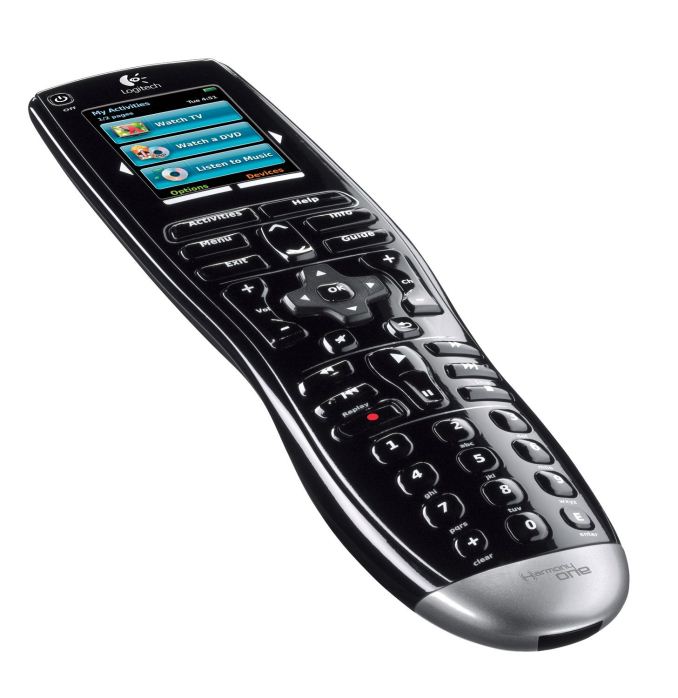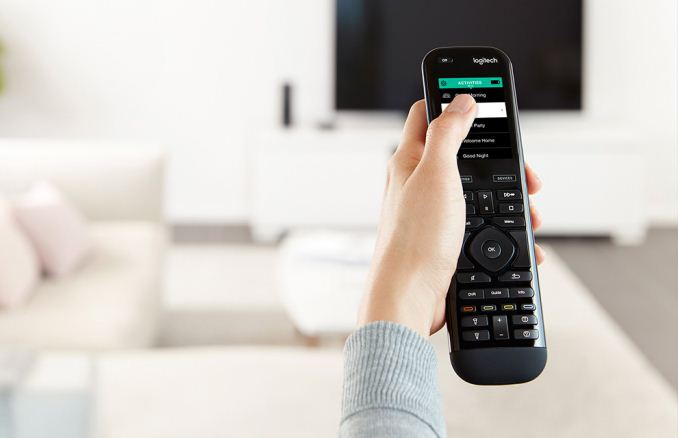The Logitech Harmony Elite Experience: Ultimate Control
by Brett Howse on February 14, 2017 8:00 AM EST- Posted in
- Accessories
- Logitech
- Remote Control
- IoT
- Smart Home
- Harmony

Perhaps I’m dating myself, but the television in my house when I was young required the viewer to get up and change channels manually. Although it wasn’t very convenient, there were only two channels, and the satisfying ker-chunk of the switch almost made it worth it. We’ve come a long way since then, and now the ubiquitous remote control seems like it’s just part of normal life. But just because something has become normal, doesn’t mean it can’t be improved.
Harmony remotes have been improving on the standard universal remote control for over a decade, and Logitech purchased the founding company back in 2004. There have been quite a few iterations on the Harmony remote, and the Logitech Harmony Elite is the current top of the line model from Logitech, incorporating the Elite remote, the Harmony Hub, and the Harmony app, into one complete solution for not only remote control, but also home automation.
My previous remote - the Logitech Harmony One
I’ve been a Harmony user for over ten years now, starting with a Harmony 880, then the Harmony One, and now the Harmony Elite. The latest model improves on its predecessors in several ways, but keeps the original brilliance of the Harmony series with a single, easy to set up, and powerful solution to replace the myriad of remotes for all of the devices in your home.
| Logitech Harmony Products | |||||
| Product | Harmony 350 | Harmony 650 | Harmony 950 | Harmony Companion | Harmony Elite |
| Maxium Devices | 8 | 8 | 15 | 8 | 15 |
| Display | None | Color | Color Touch | None | Color Multi-Touch |
| Control Type | IR | IR | IR | IR/RF/Bluetooth/IP | IR/RF/Bluetooth/IP |
| Batteries | 2 AA | 2 AA | Rechargable | CR2302 | Rechargable |
| Comes with Hub | No | No | No | Yes | Yes |
| Channel Favorites | 5 | 23 | 50 | 50 | 50 |
| Price | $35 | $50 | $200 | $150 | $300 |
Logitech created the Harmony Hub a few years back, and was their first play into the game of home automation. The Harmony Hub is the key to the Harmony Elite’s ease of use, and powerful integration with the home. Whereas the remote allows control over IR only, the Hub gets connected to the home network, allowing it to control devices through IP, and it also supports Bluetooth control. This widely expands to capabilities of the remote, from just controlling A/V equipment, to now allowing control of smart home devices like the Nest thermostat, Phillips Hue, Lutron lighting, Sonos, and more. Adding the capabilities of IP control also make the experience no longer require line of sight, and the control is more reliable than IR alone.
But the key to the overall ease of use with Harmony continues to be its unique activity-based control. For those that haven’t used it, I’ll give a quick overview of the concept.
Activities
The original genius with Harmony, especially compared to other Universal remote controls, was that Harmony groups devices into activities. The typical setup would be one remote per device, so if you want to watch a movie, you may need a remote to power on the television and choose the correct input, a remote for the A/V Receiver to select the input and control the audio, and a third remote for the disc player. Then, if you wanted to watch television, you’d turn off the disc player, switch the inputs on the TV and Receiver, and then pick up the cable box remote to change channels. This is somewhat of a worst-case scenario of course. Perhaps the television remote will also control the DVD player or cable box in some manner, but regardless this is how most people operate an entertainment setup. Even the best universal remote control is always some sort of compromise, since inevitably there will be some function you need to perform on a device that will require you to dig out the remote for it.
Harmony dispenses with this silliness. By grouping devices into activities, the remote will perform every function required automatically, and it will then control the correct devices for that activity. For instance, when you decide you want to watch a movie, you can select the activity titled “Watch a Movie” on the remote. It will then power on the correct equipment, select the correct inputs, and automatically switch the remote functions to support the activity. Play/Pause and the like will be mapped to the disc player, and volume control will be for the A/V Receiver. You can customize each activity to suit your individual tastes, and every single button can be mapped to other functions if you need to change any of the functions. Then, when you want to watch television instead, pressing “Watch TV” will power off the disc player, power on the cable box, select the correct inputs, and remap the remote buttons as required.
For any of those rare times where you need to control some obscure feature of your equipment, Harmony also has a Devices mode, where you can pick a single device and get full control of it and all of its features.
The combination of activities and devices make the cumbersome process of controlling several devices into a simple, seamless task. The Harmony Elite builds on this already powerful control that Harmony has always had, but the underlying philosophies are the same.












99 Comments
View All Comments
Azethoth - Monday, February 20, 2017 - link
Teach them how to use the help button then.I had to teach my Mom that one and now she can fix her own issues.
kpb321 - Tuesday, February 14, 2017 - link
Devices certainly can get out of sync but to some extent it depends on your devices and what commands they support. If your devices support discrete codes for the major things you do like switch the input and turn off/on then if you set it up correctly then it doesn't really matter if things are "out of sync" because they still work. For example my receiver has discrete codes for turning off and on and for switching to a particular input. Switching to an input will also turn it on if it is off so it never suffers from out of sync issues. The biggest out of sync offenders seem to be TVs when you have to switch their inputs as discrete input codes seem to be much less common there.Unfortunately the one issue I haven't been able to figure out yet is that my harmony remote seems to be really slow sending the commands to multiple devices so my wife has problems not waiting long enough for all the commands to be sent. In that regard my previous universal remote with some simple macros actually worked better as it blasted the commands to the different devices very quickly.
schizoide - Tuesday, February 14, 2017 - link
I strongly suggest the Harmony Smart Control over the Harmony Elite.https://smile.amazon.com/Logitech-Harmony-Control-... (not a referral link)
The main difference is the remote has no touchscreen. It's smaller, takes a coin battery, and the battery lasts for an ENTIRE YEAR.
The Harmony Smart Control also comes with the Harmony Hub so you get the same functionality. It's normally priced at $125, which is a bit over a third of the ridiculously expensive $300 Harmony Elite, but is frequently available factory refurb (essentially new) for $99, and just last week I saw a sale on slickdeals.net for $65.
Get the Smart Control. It's worth every penny. The Elite is overpriced and IMO actually offers an inferior experience as it needs to be constantly recharged.
archon810 - Tuesday, February 14, 2017 - link
This. I have a Harmony Smart Control and 3 Home Control remotes, all purchased at around $100-130 each, and they do almost everything this Elite does, for 1/3 the price. Plus, no need to look down - everything can be done by touch.Logitech is insane for charging $300 for something that is completely unnecessary. It should be at $180 max. DOA otherwise.
alfredoh - Tuesday, February 14, 2017 - link
This x1000. Not only is it fairly cheap at $125, but if/when the buttons on the remote break (or you lose the remote), you can buy JUST the remote for $30 and re-pair it with the existing hub in 10 seconds. I'm tempted to buy a few extra remote's for $30 just in case they stop selling the things cause they realize that people have caught on and aren't stupid enough to buy these fancy touch remote's for hundreds.ABR - Wednesday, February 15, 2017 - link
+1, just bought one in Europe, but I think it might be discontinued now? The size is really nice, I mean most of the time anyway you are using just volume, play/pause/next, and maybe channel change. Programmable buttons and, if needed, the app, cover the rest. Two minuses:- Requires a 2.4GHz network to set up, and every time to boot up. I mean, really? Solved by temporarily activating connection sharing from my smart phone, but a pain.
- Flaky sometimes, especially with sequences.
Guspaz - Tuesday, February 14, 2017 - link
Two things that I'd like to know as a Harmony One user:1) Does it support macros, so that you can program the remote to navigate a menu? For example, my Harmony can turn "night mode" on and off on my soundbar, but this requires the macro to push something like "menu-down-down-right-down-down-right-menu". That's over the max length limit on the macro so I had to combine some into custom signals. I know Harmony dropped support for macros entirely at some point, do they support macros today?
2) The Harmony One is super slow at pushing individual buttons, making it very painful to use it to navigate an on-screen menu. Did they fix this in newer remotes?
schizoide - Tuesday, February 14, 2017 - link
1) I know you can create macros with >20 discrete steps tied to activities, but haven't really played around beyond that. The software is very powerful so I expect it is possible to tie them to any button. But research it first, if you don't get any other responses.2) You can adjust timings in the harmony software down to tenths of a second.
OzzieGT - Tuesday, February 14, 2017 - link
I'm using the much cheaper harmony companion with the most basic remote in my home theater. It works great. No need for a fancy touch screen remote, the basic remote does what I need and if I need more advanced functionality I just load up the app on my phone.pookguy88 - Tuesday, February 14, 2017 - link
the thing I hate about the hub is it adds a delay whenever you press a button on the remote, can you opt to only use the remote to output IR?